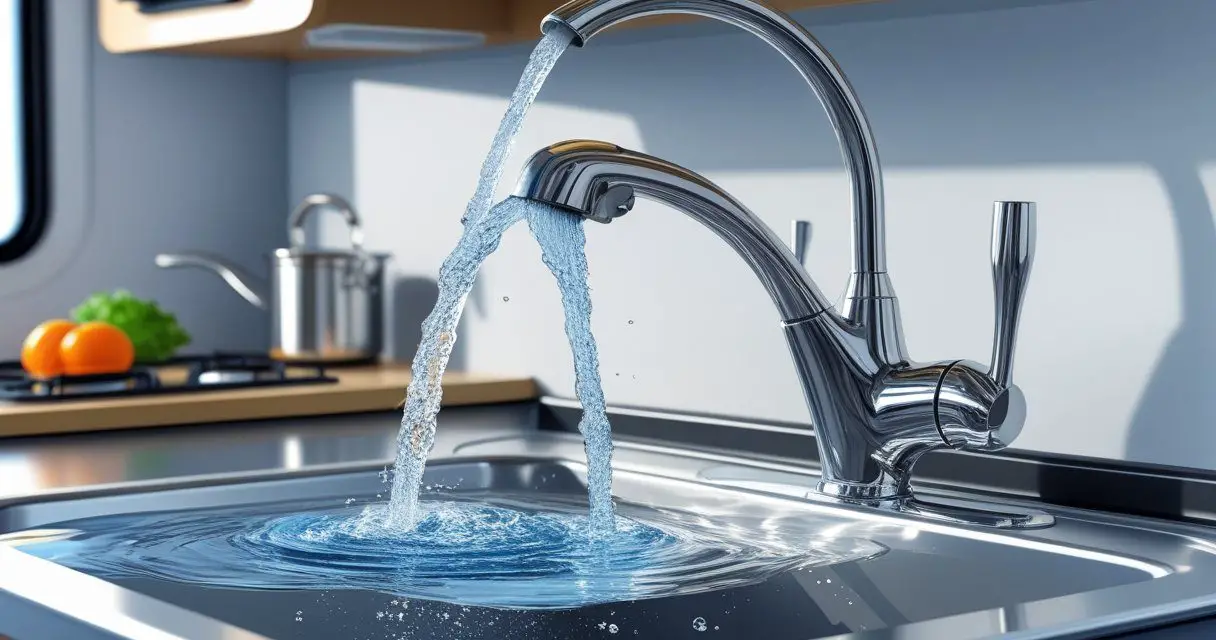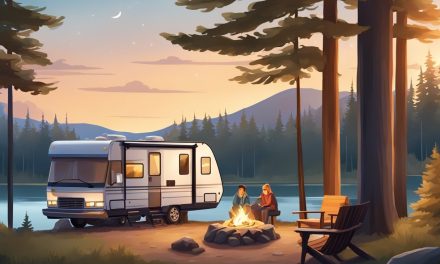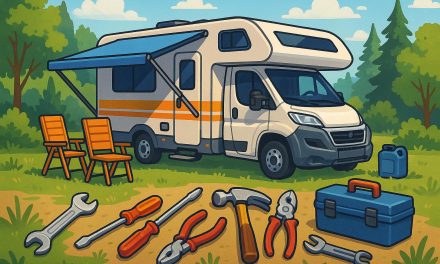Would you like to save this article?
Keep your family healthy on the road with this simple guide to preventing and removing mold in your RV’s fresh water tank
The Short Answer: Yes, Your RV Fresh Water Tank CAN Grow Mold
If you’re wondering “can RV fresh water grow mold?” – the answer is a definite YES. Your RV’s fresh water system is actually the perfect place for mold, bacteria, and algae to grow. Here’s why this happens and what you can do about it.
RV fresh water tanks create ideal conditions for mold growth because they’re:
- Dark (mold loves darkness)
- Moist (water everywhere!)
- Warm (especially in summer)
- Often stagnant (sitting water when not in use)
Watch this helpful video on sanitizing your RV water system:
Why Mold Grows in RV Fresh Water Tanks
The Perfect Storm for Contamination
Your RV’s water system is like a tiny, enclosed ecosystem. Unlike your home’s water system that flows constantly, RV tanks often sit with stagnant water for days or weeks. This creates perfect breeding conditions for:
- Black mold (the dangerous kind)
- Green algae (makes water taste gross)
- Bacteria (can make you sick)
- Mildew (creates awful smells)
Common Causes of RV Water Tank Mold
🚫 Leaving water sitting too long
- Water that sits for more than 2 weeks starts growing things
- Even “clean” water can develop problems
🚫 Using contaminated water sources
- Questionable campground water
- Well water without testing
- Hose that’s been sitting in the sun
🚫 Poor ventilation
- RV tanks don’t “breathe” like home plumbing
- No air circulation means stagnant conditions
🚫 Warm temperatures
- Heat makes everything grow faster
- Summer storage is especially risky
Health Risks: Why This Matters for Your Family
What Happens When You Drink Moldy Water?
Consuming water with mold or bacteria isn’t just gross – it can make you seriously sick:
Immediate symptoms:
- Upset stomach and nausea
- Diarrhea
- Headaches
- Throat irritation
Serious health concerns:
- Respiratory problems
- Infections
- Allergic reactions
- Long-term health issues
Kids and elderly family members are especially at risk and can get sicker faster.
How to Tell if Your RV Water Tank Has Mold
Warning Signs to Watch For
👃 Smell Test
- Musty, earthy odors
- Rotten egg smell
- Any “off” smell when you turn on faucets
👀 Visual Clues
- Black or green chunks in water
- Slimy buildup around faucets
- Discolored water
👇 Taste Changes
- Metallic taste
- Bad or weird flavor
- Water doesn’t taste “right”
📉 Water Pressure Issues
- Reduced flow from faucets
- Clogged lines (algae can block pipes)
The “Sniff Test” Method
- Turn on your water pump
- Open each faucet one at a time
- Smell the water as it comes out
- Any strange odor = time to clean!
How Often Should You Clean Your RV Water Tank?
Cleaning Schedule by RV Usage
| RV Usage Type | Cleaning Frequency | Why This Often |
|---|---|---|
| Full-time RVers | Every 6 months | Daily use, constant exposure |
| Weekend warriors | Once per year | Less frequent use, but still necessary |
| Seasonal campers | Before and after season | Long storage periods need extra care |
| After storage | Always clean first | Stagnant water grows things fast |
Special Cleaning Situations
Clean IMMEDIATELY if:
- RV has been stored for more than 2 weeks with water
- You used questionable water sources
- There was a “boil water” notice in your area
- You smell or taste anything strange
- After buying a used RV (you don’t know the history)
Step-by-Step: How to Clean Mold from Your RV Water Tank
What You’ll Need
Basic supplies:
- Unscented bleach (¼ cup per 15 gallons)
- Clean water source
- Funnel or pitcher
- Protective gloves
Optional but helpful:
- Water testing strips
- Flashlight (to inspect tank)
- Extra hose for flushing
The Complete Cleaning Process
Step 1: Safety First
- Turn OFF water heater and wait 10 minutes
- Turn OFF water pump
- Put on gloves (bleach can hurt skin)
Step 2: Drain Everything
- Open fresh water drain valve
- Open all faucets to drain lines
- Let everything drain completely
Step 3: Mix Your Cleaning Solution
- Golden ratio: ¼ cup bleach per 15 gallons of tank capacity
- Mix bleach with 1 gallon of water FIRST
- Never pour straight bleach into your tank
Step 4: Add Solution and Fill Tank
- Pour mixed solution into tank using funnel
- Fill rest of tank with clean water
- Make sure tank is nearly full
Step 5: Circulate Through System
- Turn on water pump
- Run each faucet until you smell bleach
- Don’t forget shower and outside faucets
- This ensures solution reaches all pipes
Step 6: Let It Work
- Let bleach solution sit for 6-8 hours
- Many RVers do this overnight
- Pro tip: Drive around the block to slosh solution around
Step 7: Flush and Rinse
- Drain entire system again
- Refill with fresh water
- Run all faucets until no bleach smell remains
- May need 2-3 rinse cycles
Here’s a detailed video showing the complete sanitizing process:
Alternative Cleaning Methods (Beyond Bleach)
Vinegar Method: Natural but Limited
How it works:
- Mix 2-3 gallons white vinegar with full tank of water
- Follow same process as bleach method
- Less effective against serious mold
Pros:
- Natural and eco-friendly
- Won’t harm septic systems
- Safer for people with sensitivities
Cons:
- Not as effective against bacteria
- Takes longer to work
- May not kill all mold types
Hydrogen Peroxide Method
Mixing ratio: ¼ cup of 3% hydrogen peroxide per gallon of water
Good for:
- People who can’t use bleach
- Killing bacteria and mold
- Safer than bleach
Commercial RV Sanitizers
Popular brands include:
- Thetford Fresh Water Tank Sanitizer
- Star Brite Aqua Clean
- Camco RV Pro-Strength Cleaner
Benefits:
- Designed specifically for RVs
- Often easier to use
- Some work faster than bleach
Watch this professional demonstration of RV water system sanitizing:
Prevention: Stop Mold Before It Starts
Smart Water Habits
🔄 Keep water moving
- Use fresh water regularly
- Don’t let it sit for weeks
- Run faucets occasionally even in storage
💧 Use quality water sources
- Test unknown water sources
- Use water filters when filling
- Avoid questionable campground water
🌡️ Control temperature
- Park in shade when possible
- Insulate tanks if needed
- Empty tanks before hot storage
Storage Best Practices
For short-term storage (under 2 weeks):
- Keep tank full to prevent air circulation
- Add a small amount of bleach for protection
For long-term storage:
- Empty and sanitize before storage
- Leave tanks empty
- Add RV antifreeze to lines in winter
The “Fresh Water Tank Rule”
Never leave plain water sitting for more than 2 weeks – this is when bad things start growing fast.
Tools and Products That Make Life Easier
Essential RV Water Tools
| Product | Purpose | Why You Need It |
|---|---|---|
| Water pressure regulator | Protects your system | Prevents damage from high pressure |
| Inline water filter | Removes contaminants | Cleaner water going in = less problems |
| Water testing kit | Check water quality | Know what you’re dealing with |
| Tank monitor | Track water levels | Avoid running dry or overfilling |
Recommended Cleaning Products
For regular maintenance:
- Camco Pro-Strength Cleaner
- Thetford Tank Sanitizer
- Regular unscented bleach
For serious mold problems:
- Professional RV cleaning services
- Stronger sanitizing solutions
- System replacement (if too contaminated)
Here’s a comprehensive guide to RV water system maintenance and common mistakes to avoid:
When to Call a Professional
DIY vs. Professional Cleaning
You can handle it yourself if:
- Mild odor or taste issues
- Regular maintenance cleaning
- You’re comfortable with the process
Call a professional if:
- Strong mold smell that won’t go away
- Black chunks in water
- Multiple cleanings haven’t worked
- Health problems after drinking water
- Extensive system contamination
Professional Services Cost
- Basic tank cleaning: $100-200
- Full system sanitization: $200-400
- System replacement: $500-2000+
Frequently Asked Questions
Can I drink RV water after cleaning?
Yes, but only after thorough rinsing. Make sure you can’t smell any bleach before drinking.
How long does bleach last in water?
Bleach breaks down within 24 hours, which is why the cleaning process works safely.
Is it safe to dump bleach water?
Not on the ground! Only dump into proper RV dump stations or sewer connections.
Can mold come back after cleaning?
Yes, if you don’t maintain the system. Regular cleaning prevents re-growth.
What if my tank is permanently damaged?
Severely contaminated tanks may need complete replacement. A professional can assess this.
For additional guidance on avoiding common sanitizing mistakes, watch this helpful video:
Quick Reference: Emergency Mold Cleaning
If you discover mold and need immediate action:
- Stop using the water immediately
- Get bottled water for drinking/cooking
- Start bleach cleaning process right away
- Don’t drink tank water until cleaning is complete
- Consider professional help if problem seems severe
The Bottom Line: Your Health Comes First
Yes, RV fresh water can absolutely grow mold – but it doesn’t have to be a scary problem. With regular maintenance and smart habits, you can keep your water system clean and your family healthy.
Remember the key points:
- Clean your tank every 6 months (full-timers) or yearly (occasional users)
- Never ignore strange smells or tastes
- Use proper bleach ratios for safe cleaning
- When in doubt, get professional help
Your RV should be a place of adventure and freedom – not worry about whether your water is safe to drink. Take care of your water system, and it will take care of you!
Sources
- Escapees RV Club – How to Sanitize Your RV Fresh Water Tank
- Unique Camping + Marine – Sanitizing Your Holding Tanks
- Indoor Doctor – Mold Growth in Campers
- National RV Training Academy – Sanitizing RV Water Systems
- RV Education 101 – How to Sanitize RV Water System
- All About RVs – How To Sanitize Your RV Water System
- EnjoyTheJourney.Life – RV Water System Maintenance
- Randi’s Adventures – RV Tank Sanitizing Mistakes





